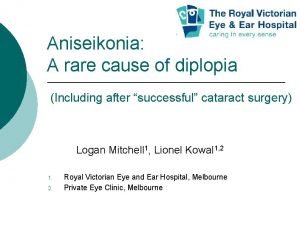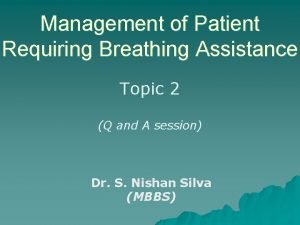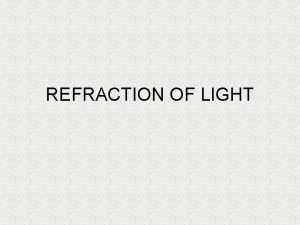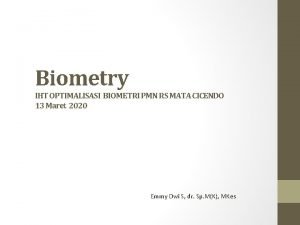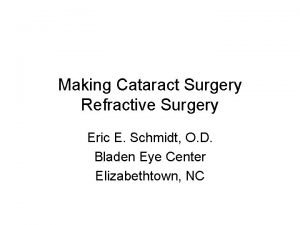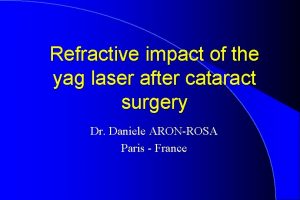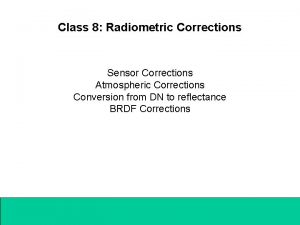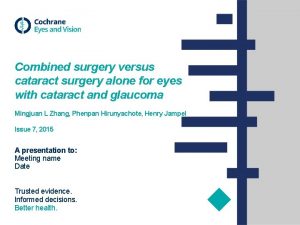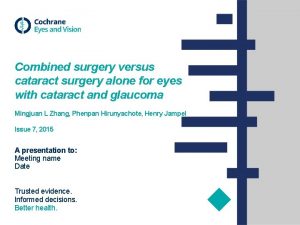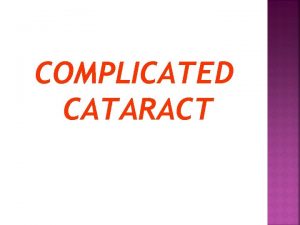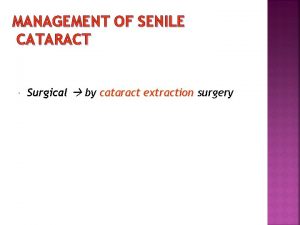REFRACTIVE ASPECTS OF CATARACT SURGERY OPTICAL CORRECTIONS AFTER
















- Slides: 16

REFRACTIVE ASPECTS OF CATARACT SURGERY

OPTICAL CORRECTIONS AFTER CATARACT EXTRACTION

APHAKIA • Aphakia: absence of the lens of the eye • Lens – 1/3 of the refractive power of the eye • After cataract extraction (removal of the opaque lens) aphakic eye the eye will be hypermetropic

CORRECTION OF APHAKIA 1. Insertion of an intraocular lens at the time of surgery 2. Contact lenses 3. Aphakic spectacles

INTRAOCULAR LENSES (IOLs) • Best optical results • Widely used in developed countries, increasingly used in developing ones • Placed at the site of natural lens • Mimic performance of the natural lens • Can’t change shape the eye can’t accommodate • Pseudophakic: an eye with an IOL

TYPES OF IOLs 1. 2. 3. 4. 5. Standard IOLs Multifocal IOLs Accommodative IOLs Toric IOLs Monovision

STANDARD IOLs • Regain your full quality of vision - Restore quality of vision experienced before cataract • Still need glasses/contact lenses - Standard IOLs provide clear vision at one distance - Need glasses/contacts for near, mid-range or distance - Clear distance vision is most important for most patients

MULTIFOCAL IOLs • Reduce dependence on glasses - High success rate - Enough eyesight improvement; either never OR only occasionally need to wear glasses after surgery • When you may need glasses: - Read fine print - See more clearly in low light conditions - Obtain the best vision at intermediate distances, like at the computer • Possible night vision symptoms - notice some rings around lights at night - night driving more challenging than with standard or accommodative IOLs

ACCOMMODATIVE IOLs • Reduce dependence on glasses - an excellent quality of vision - enough eyesight improvement - need glasses to fine-tune the distance or near vision • When you may need glasses: i. single-focus lenses excellent distance vision - to gain clear vision of near objects, the eye muscles need to strengthen make the lens move improvement - need reading glasses for close vision ii. eye muscles are unable to adjust - reading glasses • Less risk for night vision symptoms

TORIC IOLs • Correct astigmatism and cataracts • Monofocal lenses - only provide clear vision at one distance - need glasses or contacts for near, mid-range OR distance vision • Follow-up: i. may shift its position as the eye heals - need to have it realigned to see clearly again - people with astigmatism may need additional procedures (e. g. LASIK, limbal relaxing incisions) for best vision

MONOVISION • Implanting a monofocal IOL for distance vision in one eye, while implanting one for near vision in the other • The brain adjusts quickly to monovision - Joins the information from both eyes together - Can see near, intermediate and far objects clearly. • Eyesight improvement for both near and distance vision • If toric IOLs are used - correct astigmatism

CONTACT LENSES • Worn at the surface of the cornea • Produce slight magnification of the retinal image (110%) – not of visual significance • Insertion, removal and cleaning can be difficult for: - elderly patients - those with physical disabilities (e. g. arthritis)

APHAKIC SPECTACLES • Corrective spectacles • Provided when no IOL is used • Disadvantages: - Powerful positive lenses which magnify the retinal image by about 133% patient will misjudge distances - Can cause aniseikonia (disparity in image size) & symptoms (e. g. dizziness, diplopia) if used to correct one eye in: i. the other eye is phakic (the natural lens is in situ) ii. the other eye is pseudophakic - Induce optical aberrations: i. distortion of image due to thickness of the lens

GOALS OF CATARACT SURGERY • Cataract surgery is now emphasizing not only on the extractive aspects but also to perfecting refractive outcomes, either; - Emmetropic; OR - Predetermined amount of ametropia

• Factors that lead to obtaining ultimate surgical result: i. Accurate lens power calculations ii. Control of surgically induced astigmatism: - Smaller cataract incisions a. Eliminate surgically induced astigmatism b. Quicker and more stable postoperative visual rehabilitation iii. Reduction of preexisting astigmatism: - Combining astigmatic keratectomy along with phacoemulsification and IOL implantation - The use of toric lenses - Surgery on the steepest axis iv. Treatment of pseudophakic loss of accommodation

THANK YOU
 Anisekonia
Anisekonia Modified monovision
Modified monovision Nursing management for cataract
Nursing management for cataract Blended vision
Blended vision After me after me after me
After me after me after me John 14:1-3
John 14:1-3 Early recovery after surgery
Early recovery after surgery Sore throat after surgery
Sore throat after surgery Hemorrhoid surgery
Hemorrhoid surgery Fgm meaning
Fgm meaning Lower lip ptosis
Lower lip ptosis Slimline 750 refractive index
Slimline 750 refractive index Perspex refractive index
Perspex refractive index Complex refractive index
Complex refractive index Refractive amblyopia
Refractive amblyopia Alat biometri mata
Alat biometri mata Refractive surprise
Refractive surprise
